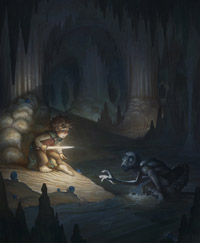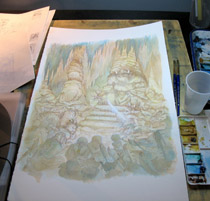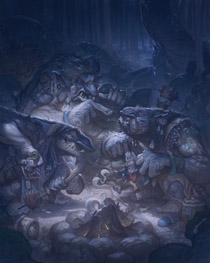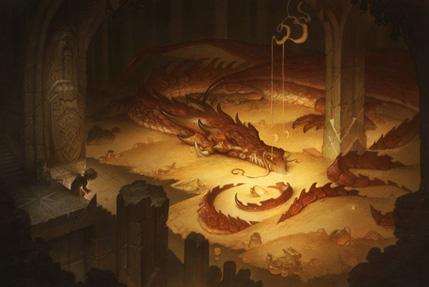I recently fell into Justin Gerard’s The Hobbit project and fell in love. Justin is finishing up a self-motivated series of Hobbit paintings as a means to recapture his own mental-images of the story and dive more deeply into traditional painting. Painting, he doesn’t seem to have much trouble with, and I imagine he finds The Hobbit full of joy ’cause that’s what these paintings are made of. Along with the paintings, his blog includes sketches, in depth progress shoots, selected quotes and personal thoughts on the book.
There is so much heart in this project, I had to ask….
Has doing the paintings made you respond to the book differently, and have you discovered something about the book that you hadn’t realized before?
 Yes and yes. I try to do as much research as possible when I start a project like this, and just by nature of studying the text from the end of not wanting to miss any details however small, I pick up a lot of new things that I hadn’t before when I was just reading for the pleasure of it.
Yes and yes. I try to do as much research as possible when I start a project like this, and just by nature of studying the text from the end of not wanting to miss any details however small, I pick up a lot of new things that I hadn’t before when I was just reading for the pleasure of it.
One thing that I began to realize about the books is how The Hobbit is different from the Lord of the Rings. The Hobbit is told very much from the viewpoint of Bilbo, a hobbit who, as Tolkien pointed out later in his career, took liberties with his telling of the stories. Tolkien called him an unreliable narrator. Bilbo was telling a storybook version of the events that transpired over the course of The Hobbit. The Lord of the Rings is a little more literal, and doesn’t seem as affected by the vagaries of perception that seem to exist in Bilbo’s version of the events in The Hobbit. I found that The Hobbit was more subjective while the LOTR was more objective. In many ways this makes The Hobbit a more charming and less epic of a story than the later trilogy. The Hobbit is a bit more like a fairy tale or something from J.M. Barrie, while the Lord of the Rings feels more inspired by British historical literature from the crusades, and maybe a little of the apocalyptic writings of Blake.
In the illustrations I found that I wanted to support Bilbo’s telling of the events as a story that’s interesting over a story that is, strictly speaking, true. So I hope that the the pieces feel more charming than epic. If I ever get into doing pieces based on the trilogy I think that I will want them to feel more epic.
I do feel like I have gotten to know the characters better as I’ve drawn these out. All the ideas and notions I had from reading the books were at first disconnected and hazy in my mind, and when I put them down onto paper they become solid and tangible. Often they will surprise me when I see everything finally realized and all together. For instance, all of the elements in the scene of Smaug were in my head in separate images, the winding stone stairs, the hills of gold, the goblet, the bats, the stone statues of dwarves and of course Smaug himself, but once it was all assembled together, it was surprising for me to actually see it, it was something new that I hadn’t really expected. And that is always a cool experience for me.
The images play out like movies in my head, which is sort of an addicting experience and is why I will do this stuff even after the money runs out. I just really enjoy watching the stories unfold and reveal themselves through the illustration.
 How has the project affected the way you work, and do you think you learned something about picture making by being so engrossed in one story?
How has the project affected the way you work, and do you think you learned something about picture making by being so engrossed in one story?
The project has affected me immensely on a technical level. I feel like I have learned a tremendous amount both on materials as well as drawing. Each piece I tried a few different new techniques on. I discovered a lot of great new tricks and I can’t wait to get to use them on the next pieces.
In many ways, the paintings are me just transcribing what was in my head when I first read this stuff years ago, but that I felt I lacked the ability to adequately communicate. Now I hope that I have a stronger grasp of the technical skills to actually attempt it and do this great story some measure of justice. I don’t think I could have really done this a year ago. I feel like the previous projects done in my down time (like Beowulf) have opened the doors that allowed me to do this one.
That is the great thing about the slow times as an illustrator. I believe that while the slow times are often stressful, since bills keep coming even if work does not, it is often the slow (and desperate) times when I learn the most. As soon as the work runs out I find myself starting on my own projects. Along with the joy of being able to do a few stories that you have always wanted to do, it also gives you the chance to better your portfolio and increase your technical abilities through practice. All of which can also help pull you out of the slump. So I see these down times as almost absolutely essential for personal development. When you are working for you, there is never the stress of a piece being finished correctly by an impending deadline. You can screw up and learn from it and it doesn’t affect you professionally. (There is actually one piece that I never put up in The Hobbit series because I tried something really outlandish as an experiment and the piece fell apart.) But that is the great thing about doing these projects. I know what type of bristols are made by angels and which are made by demons and now my art will be better in the future for it.
 I feel like I learned more about what works and what does not for making a picture more narrative. It seems that cinema, at its best, is like music, in that it is a sequence of information that must be taken in over a period of time to make logical sense. Illustration is different in that it is possible for the information to be communicated all at once. For me, the very best illustration tries to utilize the effect of information being communicated over time and in a logical sequence by means of a composition that leads your eye essentially through the story.
I feel like I learned more about what works and what does not for making a picture more narrative. It seems that cinema, at its best, is like music, in that it is a sequence of information that must be taken in over a period of time to make logical sense. Illustration is different in that it is possible for the information to be communicated all at once. For me, the very best illustration tries to utilize the effect of information being communicated over time and in a logical sequence by means of a composition that leads your eye essentially through the story.
One of the best in the world at this effect today is Paul Bonner. He is spooky good. I mean like, must have made a deal with the devil good. When you look at his pieces there are several focal points, and they are arranged in such a way that your eye can move around the image and the story within will reveal itself. And some of his stuff begins to bend your mind in a way because if you look at it in one arrangement the story appears one way, and if you look at it another it presents itself in a completely different way. He is a wizard.
Okay, sorry that was all so long. This Hobbit stuff is the most exciting stuff that I’ve had a chance to work on in a long time. I get carried away…
Check out Justn Gerard’s website and blog, and Tor.com gallery.










